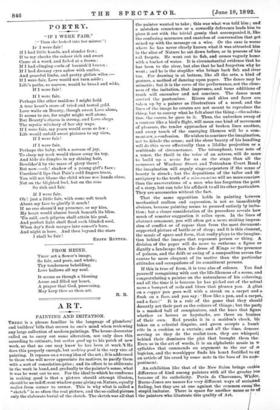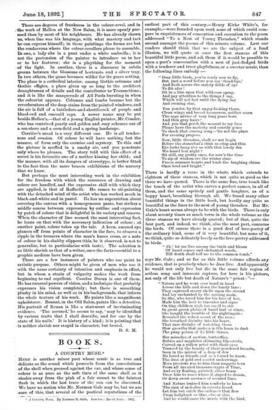ART.
PAINTING AND IMITATION.
THERE is a phrase familiar in the language of plumbers' and builders' bills that occurs to one's mind when reviewing any large collection of modern paintings. The house-decorator called on to carry out some alteration, not only does this according to estimate, but makes good up to his patch of new work, so that no one may know he has been at work. 't He does this properly enough, but making good is the very vice of painting. It reposes on a wrong idea of the art ; kis addressed to those who will never appreciate its motives, to pacify them with a sort of consolation-prize; and its effect is to obliterate in the work in hand, and gradually to the painter's sense, what it was he went out to see. For the ideal to which he conforms in making good is that a picture should attempt illusion, should be an indifferent window-pane giving on Nature, equally realist from corner to corner. This is why what is called a " sketch " is so often the real picture, and the so-called picture only the elaborate burial of the sketch. The sketch was allthat
the painter wanted to take ; this was what was told him ; and a mistaken conscience or a cowardly deference leads hint to piece it out with the trivial gossip that accompanied it, Ike the confusing murmurs and snatches of conversation that get mixed up with the message on a wire. Or the case is worse where he has never clearly known what it was attracted him in the slice of Nature he sat down before, or in process of his toil forgets. He went out to fish, and comes vaguely home with a bucket of water. It is circumstantial evidence that he has been to the river, but also that he had forgotten why he went ; and he is the stupider who brings back fish and river too. For drawing is at bottom, like all the arts, a kind of gesture, a method of dancing upon paper. The dance may be mimetic ; but it is the verve of the performance, not the close-
ness of the imitation, that impresses, and tame additions of truth will encumber and not convince. The dance must control the pantomime. Rivers and skies and faces are taken up by a painter as illustrations of a mood, and the lines of the image he creates are not meant to reproduce the thing. but to convey what he felt about the thing.—the saluta- tion, the caress, he gave to it. Thus, the unbroken sweep of a contour like a bird's flight, will mean one kind of movement of pleasure, the tender approaches of broken lines another, and every touch of the emerging likeness will be a com- mentary, a confession. He wishes to convince the imagination, not to delude the sense; and the sheer beauty of his handling will do this more effectually than a lifelike projection or a multitude of circumstance. The triumphant, true note of a tenor, the thrill in the voice of an actress, will do more to build up a scene for us on the stage than all the resources of Wardour Street and Tottenham Court Road ; the imagination will supply stage-carpenters if the sense of beauty is struck ; but the depositions of the tailor and OA antiquary to the truth of a mise-em-scae will no more conviree
than the asseverations of a man who has forgotten the pant of a story, but can take his affidavit to all its other particutars. They are accessories without the fact.
That the same opposition holds in painting between mechanical realism and expression, is not so immediately , obvious, because painting seems to proceed entirely by imita- tion; but acloser consideration of its procedure rereals how much of remoter suggestion it relies upon. In the lines of abstract ornament, you will often get a more striking impres- sion of conflict or of repose than from the most document- supported picture of battle or of sleep; and it is this element, the music of space and form, that really plays to the imagina- tion behind the images that represent person or thing. A division of the paper will do more to enthrone a figure or dignify a landscape than the dress of Kings or the presence of palaces, and the drift or swing of a composition across the canvas be more eloquent of its motive than the particular attitudes and occupations of its constituent persons.
If this is true of form, it is true also of colours. You find yourself recognising with zest the life-likeness of a scene, and congratulating a painter on the naturalness of his colouring, and all the time it is because he has picked out of the actual mess a bouquet of reds and blues that pleases you. A glint on a copper pan goes well with a streak on a carpet and a flush on a face, and you say : How like a pan, and a carpet,
and a face It is a rule of the game that they should decently act their part as the colours of things ; but the part is a masked ball of conspirators, and the hues that figure whether as heroes or haystacks, are there on busines of their own. Red pranks it in a maiden's cheek, bit takes on a celestial disguise, and green accepts a humb role in a cushion or a curtain ; and all the time, demure serving as they do the realist turn, they are whisperit behind their dominoes the plot that brought them the. Even so in the art of words, it is an alphabetic music in le syllables that commends an argument to the ear of le logician, and the worshipper finds his heart fortified to Og an article of his creed by some note in the bass of its acciei- paniment.
An exhibition like that of the New Salon brings °utile
because of its catholicity. Puvis de Chavannes, Whiter, difference of kind among painters with all the greateritirce Burne-Jones are names for very different ways of seeinnd feeling, but they are at one against the common enen the stupid imitator. There is space for another name or o of the painters who illustrate this quality of Art.
There are degrees of frankness in the colour-revel, and in the work of Hellen at the New Salon, it is more openly pur- sued than by most of his neighbours. He has already shown us, when line was his language, with what mastery and tact he can express himself; in these paintings the forms are but the rendezvous where the colour-revellers please to assemble. In one, a lady sits in a punt under a white umbrella; it is not the pretension of the painter to introduce us to her or to her features ; she is a plaything for the moment • of the light. In another, there is a discourse in subtle greens between the blossoms of hortensia and a silver tray. In two others, the game becomes wilder for its grave setting. The place is a cathedral interior, among Gothic columns and • Gothic effigies, a place given up so long to the architect draughtsman of details and the contributor to Transactions ; and it is like the masquerade of All Fools bursting in when the colourist appears. Columns and tombs become but the reverberators of the deep stains from the painted windows, and the air is full of a battledore-and-shuttlecock of purple and blood-red and emerald rays. A newer name may be put beside Helleu's,—that of a young English painter, Mr. Conder, who has contrived pearly and golden and rosy schemes out of a sea-shore and a corn-field and a spring landscape.
Carriere's mood is a very different one. He is all tender- ness and evasion. Of colour he will have nothing but the -nuance, of form only the surmise and mystery. To this end the picture is muffled in a smoky air, and you penetrate only where he pleases. The story told with this effect of a secret is his favourite one of a mother kissing her child ; and the manner, with all its dangers of stereotype, is better fitted to the fact than the more brazen exhibitions of the nursery that we know.
But perhaps the most interesting work in the exhibition for the freedom with which the resources of drawing and colour are handled, and the expressive skill with which they are applied, is that of Raffaelli. He comes to oil-painting with the detached mind of the artist who has worked much in black-and-white and in pastel. He has no superstition about -covering the canvas with a homogeneous paste, but strikes a middle course between expression by outline and expression by patch of colour that is delightful in its variety and reserve. When the character of line seemed the most interesting fact, he leans on that with the necessary indication of colour ; at -another point, colour takes up the tale. A keen, amused eye glances off from points of character in the face, to observe a ripple in the trousers where the man's knees cross, or a note of colour in his shabby slippers (this, be it observed, is not to -generalise, but to particularise with taste). The selection is as little slavish as that of a writer, once the facts essential to a graphic medium have been given.
Those are a few instances of painters who use paint to artistic purpose. Others might be given of men who use it with the same certainty of intention and emphasis in effect, but in whom a strain of vulgarity makes the work from beginning to end repellent. Carolas Duran is one of them. He has unusual powers of vision, and a technique that probably -expresses his vision completely; but there is something plushy in his mind, as well as in his backgrounds, that infects -the whole texture of his work. He paints like a magnificent -upholsterer. Bonnat, in the Old Salon, paints like a detective.
His portrait of Renan is like a statement of incriminating evidence. The accused,' he seems to say, may be identified by various traits that I shall describe, and for one by the -state of his nails.' It is history of a kind ; it is painting that ds neither slavish nor stupid in character, but brutal.
D. S. M.







































 Previous page
Previous page